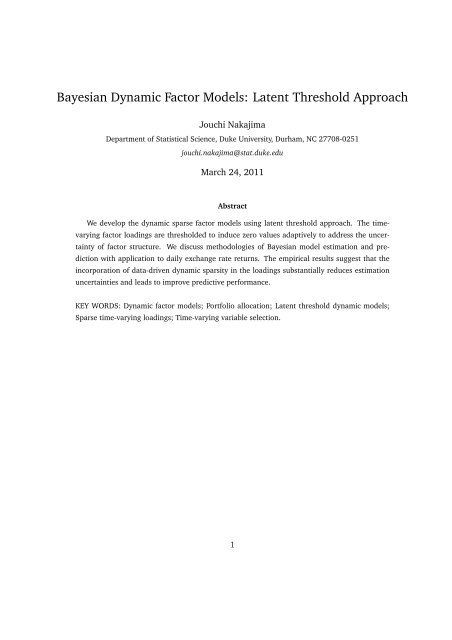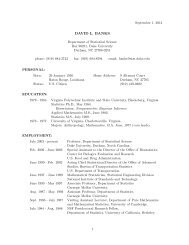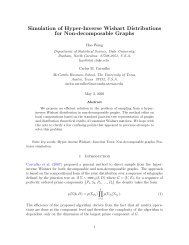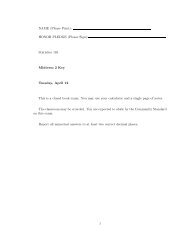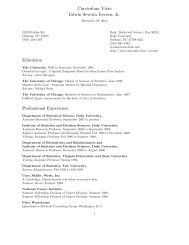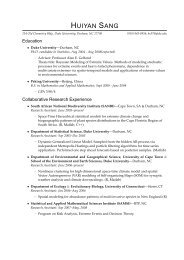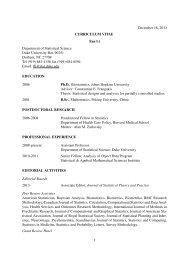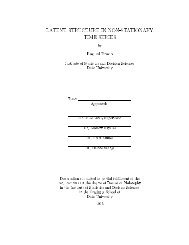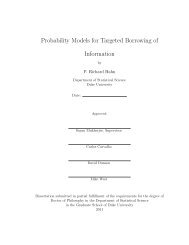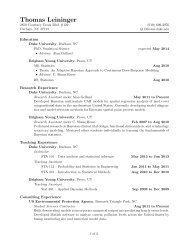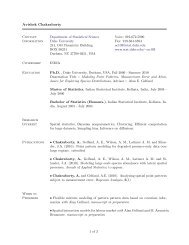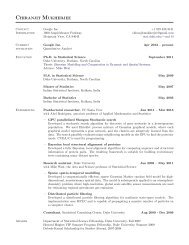Bayesian Dynamic Factor Models - Department of Statistical Science ...
Bayesian Dynamic Factor Models - Department of Statistical Science ...
Bayesian Dynamic Factor Models - Department of Statistical Science ...
Create successful ePaper yourself
Turn your PDF publications into a flip-book with our unique Google optimized e-Paper software.
<strong>Bayesian</strong> <strong>Dynamic</strong> <strong>Factor</strong> <strong>Models</strong>: Latent Threshold Approach<br />
Jouchi Nakajima<br />
<strong>Department</strong> <strong>of</strong> <strong>Statistical</strong> <strong>Science</strong>, Duke University, Durham, NC 27708-0251<br />
jouchi.nakajima@stat.duke.edu<br />
March 24, 2011<br />
Abstract<br />
We develop the dynamic sparse factor models using latent threshold approach. The time-<br />
varying factor loadings are thresholded to induce zero values adaptively to address the uncer-<br />
tainty <strong>of</strong> factor structure. We discuss methodologies <strong>of</strong> <strong>Bayesian</strong> model estimation and pre-<br />
diction with application to daily exchange rate returns. The empirical results suggest that the<br />
incorporation <strong>of</strong> data-driven dynamic sparsity in the loadings substantially reduces estimation<br />
uncertainties and leads to improve predictive performance.<br />
KEY WORDS: <strong>Dynamic</strong> factor models; Portfolio allocation; Latent threshold dynamic models;<br />
Sparse time-varying loadings; Time-varying variable selection.<br />
1
1 Introduction<br />
<strong>Dynamic</strong> factor models have been widely developed in both methodological and practical issues,<br />
and become a standard tool for increasingly high-dimensional modelling <strong>of</strong> time series. In particu-<br />
lar, flexible and parsimonious innovation structures for underlying latent process such as stochastic<br />
volatility (Aguilar and West (2000)) and time-varying loadings (Lopes and Carvalho (2007)) make<br />
the factor models more flexible and reasonable to assess the complex multivariate time series. In<br />
application <strong>of</strong> such factor analysis, the latent time-varying loadings grow quickly in dimension with<br />
the number <strong>of</strong> time series response variables and the number <strong>of</strong> factors, which typically leads to<br />
increased uncertainty in estimation. Much progress has been recently made for sparse factor analy-<br />
sis (West 2003; Carvalho et al. 2008; Lopes et al. 2010; Yoshida and West 2010) using the sparsity<br />
priors for variable selection (George and McCulloch 1993, 1997; Clyde and George 2004); but<br />
these studies assume that the loadings are constant over time.<br />
This paper develops dynamic sparse factor models by embedding the latent threshold (LT)<br />
approach <strong>of</strong> Nakajima and West (2010); the time-varying loadings are thresholded to induce zero<br />
values adaptively. The idea is that some factor loadings are practically relevant in some time<br />
periods, but irrelevant or redundant in others. Nakajima and West (2010) propose latent threshold<br />
models (LTM), a general approach to dynamic sparsity modelling in time series and state-space<br />
models. The LTM structure allows time-varying parameters for non-zero values when supported<br />
by the data while collapses them fully to zero when redundant or irrelevant. This data-driven<br />
shrinkage mechanism induces dynamic sparsity in high-dimensional parameters that change over<br />
time. In the current paper, we design the time-varying loadings with the LTM structure to focus on<br />
relevances <strong>of</strong> factors to each time series response variable. The methodology is applied to real-data<br />
study using daily exchange rate returns. Our objectives <strong>of</strong> this empirical analysis are model fitting,<br />
forecasting and dynamic portfolio decisions, and reporting practical utility <strong>of</strong> our proposed models.<br />
In Section 2, we review the dynamic factor models with time-varying loadings and stochastic<br />
volatility. In Section 3, we generalize the factor models by embedding latent threshold modelling<br />
approach, and develop a <strong>Bayesian</strong> inference and MCMC algorithm. In Section 4, we apply our<br />
proposed models to six series <strong>of</strong> daily exchange rate returns. In Section 5, a portfolio allocation<br />
study is investigated. In Section 5, concluding comments are provided.<br />
Some notation: We use the distributional notation y ∼ N(a, A), d ∼ U(a, b), p ∼ B(a, b),<br />
v ∼ G(a, b), for the normal, uniform, beta, and gamma distributions, respectively. We also use,<br />
for example, N(y|a, A) to denote the actual density function f(y) when y ∼ N(a, A), in cases<br />
where the specificity is needed; and s : t stands for indices s, s + 1, . . . , t when s < t, for succinct<br />
subscripting such as in use <strong>of</strong> y 1:T to denote {y 1, . . . , y T }.<br />
2
2 <strong>Dynamic</strong> factor models<br />
2.1 Standard model<br />
Suppose that the time series <strong>of</strong> m × 1 vector responses y t, (t = 1, 2, . . .), follows the model<br />
y t = c + Bf t + εt, εt ∼ N(εt|0, Σ), (1)<br />
f t ∼ N(f t|0, W ), (2)<br />
where c is the m × 1 mean vector, f t is the k × 1 vector <strong>of</strong> factors with k < m, B is the m × k factor<br />
loadings matrix, εt and f s are mutually independent for all t and s, Σ = diag(σ 2 1 , . . . σ2 m) is the<br />
diagonal matrix <strong>of</strong> series-specific variances, and W = diag(w2 1 , . . . , w2 k ) is the diagonal matrix <strong>of</strong><br />
factor variances. Given the latent factors f t that extract common structure in yt = (y1t, . . . , ymt) ′ ,<br />
the model (1)–(2) implies that yit and yjt are conditionally uncorrelated for all i and j; specifically,<br />
V (y t|f t) = Σ, and V (y t) = BW B ′ + Σ.<br />
Under a large m circumstance (i.e., the high-dimensional responses), in practice, the relatively<br />
small number <strong>of</strong> latent factors isolate the idiosyncratic variation <strong>of</strong> each series, from the high-<br />
dimensional covariance structure <strong>of</strong> the whole responses. In particular, this point is critical when<br />
we consider the time-varying structures that follow below. The factor modelling allows for the<br />
incorporation <strong>of</strong> flexible time-varying relations between responses and stochastic volatility not only<br />
in each series but also in common movements that may yield substantial improvements in short-<br />
term forecasting and interpretation, especially in application with a large data sets such as hundreds<br />
<strong>of</strong> financial return time series.<br />
For identification problem, the factor model requires some constraint to define the unique<br />
model, because the model (1)–(2) is invariant under location shifts <strong>of</strong> the loading matrix. Al-<br />
though there are several ways to ensure this identification, we assume here that B is the block<br />
lower triangular matrix with diagonal elements equal to one, as suggested by Aguilar and West<br />
(2000), Lopes and Carvalho (2007) (see further discussions in Lopes and West (2004)).<br />
2.2 Time-varying parameters, stochastic volatility and autoregressive factor process<br />
We consider a generalization <strong>of</strong> the standard factor model with three substantial compositions<br />
that capture important features <strong>of</strong> financial time series, <strong>of</strong>ten discussed in literature. First, we allow<br />
each free element in the loading matrix and the mean to change over time (Lopes and Carvalho<br />
(2007)). Second, we assume that the variances <strong>of</strong> the errors in eqn. (1) and the factors are time-<br />
varying in the form <strong>of</strong> stochastic volatility (Pitt and Shephard (1999), Aguilar and West (2000),<br />
Lopes and Carvalho (2007)). Third, we suppose that the latent factors follow an autoregressive pro-<br />
cess. These generalizations provide reasonably flexible and adaptive structure to address changes<br />
3
in variance and covariance structure as well as underlying time-varying common movements in<br />
multivariate time series.<br />
In the general setting, eqns. (1)–(2) are replaced by<br />
y t = ct + Btf t + εt, εt ∼ N(εt|0, Σt), (3)<br />
f t ∼ N(f t|Ψf t−1, W t) (4)<br />
where εt and es = f s − Ψf s−1 are mutually independent for all t and s. Bt is the time-varying<br />
loadings matrix; any form <strong>of</strong> model may be defined for the time-varying structure, although one<br />
<strong>of</strong> the simplest, and easily most widely useful in practice, is the vector autoregressive (VAR) model<br />
taken here. For each time t, define the p [= mk − k(k + 1)/2] × 1 vector bt by stacking the free<br />
parameters in Bt. Then, we assume that<br />
bt = µ b + Φb(bt−1 − µ b) + η bt, η bt ∼ N(0, V b), (5)<br />
a VAR(1) model with individual AR parameters φbi, in the p × p matrix, Φb = diag(φb1, . . . , φbp).<br />
We assume that Vb is a diagonal matrix and |φi| < 1, which implies that each factor loading follows<br />
a stationary AR(1) model assumed here. We also define the local mean (or time-varying intercept),<br />
ct, following the stationary VAR(1) model:<br />
where Φc = diag(φc1, . . . , φcm), with |φci| < 1.<br />
ct = µ c + Φc(ct−1 − µ c) + η ct, η ct ∼ N(0, V c), (6)<br />
The time-varying variance matrices, Σt = diag(σ 2 1t , . . . , σ2 mt), and W t = diag(w 2 1t , . . . , w2 kt )<br />
are governed by a standard stochastic volatility process with hit = log σ2 it , and λjt = log w2 jt , for<br />
i = 1, . . . , m, j = 1 . . . , k. That is, with ht = (h1t, . . . , hmt) ′ , and λt = (λ1t, . . . , λkt) ′ ,<br />
ht = µ h + Φh(ht−1 − µ h) + η ht, (7)<br />
λt = µ λ + Φλ(λt−1 − µ λ) + η λt, (8)<br />
where (ε ′ t, η ′ bt , η′ ct, η ′ ht , η′ λt ) ∼ N[0, diag(Σ, V b, V c, V h, V λ)], with each <strong>of</strong> the matrices (Φh, Φλ,<br />
V c, V h, V λ) diagonal. This process <strong>of</strong> log variances defines traditional univariate stochastic volatil-<br />
ity models widely used both alone and as components <strong>of</strong> more complex models in financial liter-<br />
ature (Jacquier et al. 1994; Kim et al. 1998; Aguilar and West 2000; Omori et al. 2007; Prado<br />
and West 2010, chap. 7). Note that here not only the series-specific variances but also the factor<br />
variances change over time, which is a quite reasonable assumption for financial multivariate time<br />
4
series because process <strong>of</strong> their latent common factor typically tends to exhibit serious time-varying<br />
variance behaviors.<br />
The final feature to mention here is that the factors are modelled to follow the stationary VAR(1)<br />
process with individual autoregressive parameters, Ψ = diag(ψ1, . . . , ψk) with |ψj| < 1. That ψj ≡ 0<br />
for all j implies the basic independent (over time) factors as in (2). These autoregressive factors as<br />
well as the local means, time-varying loadings and stochastic volatility described so far are intended<br />
not only to address underlying time-varying structure in relation to the variance and covariance<br />
structure on the factor models, but also to elaborate the structured models with greater short-term<br />
forecastabilty. Those specifications are considerably flexible and adaptive date-dependent tracking<br />
structure in means and variances for financial time series.<br />
3 Latent threshold dynamic factor models<br />
3.1 Framework<br />
The free time-varying parameters in the loading matrix grow quickly in dimensions with the<br />
number <strong>of</strong> time series response variables. This <strong>of</strong>ten leads to increased uncertainty in estimation.<br />
To address this problem, we exploit the latent threshold modelling (Nakajima and West (2010)) in<br />
the latent process <strong>of</strong> the time-varying loadings.<br />
Apart from the eqn. (5), suppose that we have the latent threshold model (LTM) structure for<br />
bt = (b1t, . . . , bpt) ′ ; that is,<br />
bit = βitsit, and sit = I(|βit| ≥ di), i = 1, . . . , p, (9)<br />
where I(·) denotes the indicator function, d = (d1, . . . , dp) is the latent threshold vector with di ≥ 0,<br />
for i = 1, . . . , p, and the latent time-varying parameters β t = (β1t, . . . , βpt) ′ follow a stationary<br />
VAR(1) model<br />
β t+1 = µ β + Φβ(β t − µ β) + η βt, η βt ∼ N(0, V β), (10)<br />
where Φβ and V β are diagonal, and |φβi| < 1. The key idea <strong>of</strong> the LTM structure is that the<br />
value <strong>of</strong> the time-varying loading is shrunk to zero when its absolute value falls below the latent<br />
threshold. The relevance <strong>of</strong> the factor to the response is time-varying; each factor plays a role<br />
in predicting the response only when the corresponding βit is large enough. For each time series<br />
response variable, the factor may have non-zero loading in some time periods but zero in others,<br />
depending on the data and context. This mechanism leads to the dynamic model uncertainty in<br />
the factor loading matrix by neatly embodying sparsity/shrinkage and parameter reduction at each<br />
time point. We refer to the model <strong>of</strong> eqns. (3), (4), and (6-10) as a Latent Threshold <strong>Dynamic</strong><br />
5
<strong>Factor</strong> Model (LTDFM). Throughout we denote the hyper-parameters <strong>of</strong> the latent VAR(1) models<br />
in the LTFLM by Θ = {µ γ, Φγ, V γ} γ=(c,β,h,λ).<br />
3.2 Priors and posterior computation<br />
<strong>Bayesian</strong> estimation <strong>of</strong> standard dynamic factor models using Markov chain Monte Carlo (MCMC)<br />
methods are described in Aguilar and West (2000), and Lopes and West (2004). Based on their<br />
works, we develop a MCMC algorithm for the LTDFM, exploring the full joint posterior distribution<br />
p(β 1:T , f 1:T , c1:T , h1:T , λ1:T , Θ, Ψ, d|y 1:T ) under certain priors distributions.<br />
First, assuming traditional priors for the VAR parameters in Θ simplifies the conditional pos-<br />
terior distribution <strong>of</strong> Θ given the other parameters and data; we obtain the set <strong>of</strong> conditionally<br />
independent posteriors, π(θγi|γ 1:T ), where γ ∈ {c, β, h, λ}, θγi = (µγi, φγi, v 2 γi ), and v2 γi denotes<br />
the i-th diagonal in V γ. Similarly, the conditional posterior distribution <strong>of</strong> ψi reduces to the con-<br />
ditionally independent posterior, π(ψi|{fit}t=1:T ). To generate the sample <strong>of</strong> these parameters,<br />
we can use standard Metropolis-Hastings (MH) methods <strong>of</strong> sampling parameters in univariate AR<br />
models.<br />
Second, sampling the factors f t can be performed by a forward-filtering, backward sampling<br />
(FFBS) algorithm (see e.g., Prado and West (2010)) to obtain the sample from the joint conditional<br />
posterior distribution <strong>of</strong> the full sequence f 1:T , which reduces a possible high autocorrelations in<br />
the MCMC draws. When we assume the standard independent factors by ψj ≡ 0 as in the model (2),<br />
the conditional posterior distribution <strong>of</strong> f t reduces to a simple multivariate normal distribution.<br />
Third, the conditional independence structure <strong>of</strong> the stochastic volatility, (h1:T , λ1:T ), allows<br />
us to use the standard MCMC technique <strong>of</strong> the traditional univariate stochastic volatility models<br />
(Kim et al. (1998), Omori et al. (2007). Shephard and Pitt (1997), Watanabe and Omori (2004)).<br />
Again, these works provide the efficient algorithm to obtain the sample from the joint conditional<br />
posterior distribution <strong>of</strong> {hit}t=1:T , and {λit}t=1:T (Prado and West (2010)).<br />
Fourth, with regard to sampling β 1:T , Nakajima and West (2010) suggest a Metropolis-within-<br />
Gibbs sampling strategy. To target on the conditional distribution <strong>of</strong> β t given β −t = β 1:T \β t and<br />
other parameters, a proposal draw can be straightforwardly generated based on the non-threshold<br />
model by fixing (s1t, . . . , spt) = (1, . . . , 1). The standard MH algorithm is completed by accept-<br />
ing the candidate with the MH probability (See Section 2.3 <strong>of</strong> Nakajima and West (2010)). This<br />
generation is implemented sequentially for t = 1 : T .<br />
Finally, following Nakajima and West (2010), we assume the prior for the latent thresholds by<br />
di ∼ U(0, |µi| + Kivi), i = 1, . . . , p,<br />
where (µi, v2 i ) are the mean and variance <strong>of</strong> the stationary distribution <strong>of</strong> the univariate AR(1)<br />
6
process for βit, with µi = µβi and v 2 i = v2 βi /(1 − φ2 βi ). This prior covers the range <strong>of</strong> βit as reflected<br />
in its marginal distribution, considering relevant values <strong>of</strong> the threshold. Their work suggests<br />
K = 3, also taken in the current paper. The generation <strong>of</strong> the posterior distribution is performed<br />
by a direct MH approach with candidate drawn from the prior.<br />
4 Application to exchange rate returns<br />
For illustration, we apply the LTDFM described above to multivariate series <strong>of</strong> foreign exchange<br />
(FX) rate returns. Our focus here is particular interest in LTM-based shrinkage to zero <strong>of</strong> time-<br />
varying factor loadings and its implications for the dynamic relations underlying the FX series.<br />
There are some connections with previous work on FX time series using the DFMs (e.g. Aguilar and<br />
West (2000), Lopes and West (2004), Lopes and Carvalho (2007)).<br />
4.1 Data and priors<br />
The data are m = 6 daily international currency exchange rates relative to US dollar over a<br />
time period <strong>of</strong> 980 business days beginning in January 2006 and ending in December 2009, The<br />
returns are computed as yit = 100(Pit/Pi,t−1 − 1), where Pit denotes the daily closing spot rate.<br />
The series are listed in Table 1; the exchange rates and returns are both plotted in Figure 1. The<br />
most striking feature in these sample periods is a quite volatile and turbulent movement triggered<br />
by the financial crisis around 2008; there are some superficial correlated flows and shifts among<br />
the series. Initial exploratory analysis using the univariate stochastic volatility fit to each series<br />
separately is summarized in Figure 2. There exist marked region-specific patterns. The peaks <strong>of</strong><br />
stochastic volatility seem to coincide in 2008, but there exist several spikes common only to two or<br />
three currencies. From these evidences and some computational experiments, we determined the<br />
order <strong>of</strong> the currencies in the y t vectors as listed in Table 1.<br />
1 GBP British Pound Sterling<br />
2 EUR Euro<br />
3 JPY Japanese Yen<br />
4 CAD Canadian Dollar<br />
5 AUD Australian Dollar<br />
6 CHF Swiss Franc<br />
Table 1: International currencies relative to the US dollar in exchange rate data.<br />
Our analysis uses the LTDFM, namely the dynamic factor model with (i) local mean, (ii) stochas-<br />
tic volatility for both individual series and factors, (iii) autoregressive factor process, and (iv) LTM-<br />
based time-varying loading matrix. We take the following priors throughout: v −2<br />
ci<br />
v −2<br />
βi<br />
∼ G(40, 0.005),<br />
∼ G(40, 0.02), v−2<br />
hi ∼ G(20, 0.001), and (φγi + 1)/2 ∼ B(20, 1.5), where γ = (c, β, h, λ), and<br />
(ψi + 1)/2 ∼ B(1, 1). For µ·i’s, we use µγi ∼ N(0, 1) for γ = (c, β), and exp(−µ˜γi) ∼ G(3, 0.03)<br />
7
2.0<br />
1.5<br />
GBP<br />
2006 2007 2008 2009<br />
0.012 JPY<br />
0.010<br />
0.008<br />
2006 2007 2008 2009<br />
1.0 AUD<br />
0.8<br />
2006 2007 2008 2009<br />
3<br />
0<br />
−3<br />
2006 2007 2008 2009<br />
3<br />
0<br />
−3<br />
GBP<br />
2006 2007 2008 2009<br />
5<br />
0<br />
−5<br />
JPY<br />
AUD<br />
2006 2007 2008 2009<br />
(i) Exchange rates<br />
1.6 EUR<br />
1.4<br />
1.2<br />
1.0<br />
0.8<br />
2006 2007 2008 2009<br />
CAD<br />
2006 2007 2008 2009<br />
1.0 CHF<br />
0.9<br />
0.8<br />
(ii) Returns<br />
2006 2007 2008 2009<br />
0<br />
−3<br />
3 EUR<br />
2006 2007 2008 2009<br />
6 CAD<br />
3<br />
0<br />
−3<br />
2006 2007 2008 2009<br />
3<br />
0<br />
CHF<br />
−3<br />
2006 2007 2008 2009<br />
Figure 1: Daily exchange rates and returns<br />
8
3<br />
2<br />
1<br />
GBP<br />
EUR<br />
JPY<br />
CAD<br />
AUD<br />
CHF<br />
2006 2007 2008 2009<br />
Figure 2: Estimated trajectories <strong>of</strong> univariate stochastic volatility (σit = exp(hit/2)) fit to each<br />
series separately.<br />
for ˜γ = (h, λ). The conditional prior for thresholds is U(di|0, |µi| + Kivi) with Ki = 3. MCMC<br />
used J = 100,000 iterations after discarding a burn-in period <strong>of</strong> 20,000 samples. Computations are<br />
obtained using Ox (Doornik 2006); code is available to interested readers.<br />
A determination <strong>of</strong> the number <strong>of</strong> factors has been a challenging issue in literature (see e.g.<br />
Lopes and West (2004) in <strong>Bayesian</strong> context). For the analysis here, we fit the LTDFM to the FX<br />
data and repeated the estimation across models with different number <strong>of</strong> factors k = 1, 2, 3, or<br />
4. We evaluated each <strong>of</strong> the resulting suite <strong>of</strong> models by forecasting over the final five business<br />
days using first 930 observations, and repeated this five-step-ahead forecasting based on the first<br />
930+5j observations for j = 1, . . . , 9, to obtain the 50-day forecasts. Based on the root mean<br />
squared errors (RMSE) for these out-<strong>of</strong>-sample forecasts, the LTDFM performs best when k = 3 is<br />
assumed, which is taken in the following analysis.<br />
4.2 Summaries <strong>of</strong> posterior inference<br />
Figure 3 displays the posterior estimates <strong>of</strong> the time-varying factor loadings, as well as the<br />
posterior probabilities <strong>of</strong> sit = 0 for the LTDFM model. The estimated latent process exhibits a<br />
considerable time variation for several loadings, which can not be captured by a constant-loading<br />
factor model. In particular, JPY-<strong>Factor</strong>1 and AUD-<strong>Factor</strong>3 are estimated positive in 2006, but turns<br />
to be negative after 2007, reflecting a shift <strong>of</strong> correlated dynamics among the FX series. The<br />
9<br />
.
trajectories <strong>of</strong> posterior mean <strong>of</strong> several loadings also evidently change over time. Time-varying<br />
sparsity is observed for the loadings <strong>of</strong> JPY-<strong>Factor</strong>1, AUD-<strong>Factor</strong>3 and CHF-<strong>Factor</strong>3, with estimated<br />
values shrinking to zero for some time periods but not others, whereas other loadings such as<br />
CAD-<strong>Factor</strong>2 and -<strong>Factor</strong>3 are totally selected out over the entire time-frame.<br />
The interesting observation <strong>of</strong> the shrinkage pattern <strong>of</strong> JPY-<strong>Factor</strong>1 in 2008 implies that the JPY<br />
returns turned to be negatively correlated with <strong>Factor</strong>1. The loadings to <strong>Factor</strong>1 are all positive in<br />
the currencies except JPY. In 2008, the financial crisis led investors to reduce their size <strong>of</strong> US dollar<br />
short position and the currencies in our analysis except JPY depreciated against US dollar, whereas<br />
the JPY temporally appreciated.<br />
Figure 4 shows the proportion <strong>of</strong> variation <strong>of</strong> the time-series explained by each factor; the time<br />
variation <strong>of</strong> each factor’s contribution to the time-series is evident. By construction, <strong>Factor</strong>1 is a<br />
GBP-leading factor, although its explanatory ratio decreases from 2006 to 2009, and there are a<br />
few downward spots in the crisis period, which indicates an idiosyncratic variation <strong>of</strong> the GBP.<br />
<strong>Factor</strong>2 is recognized as an European factor that mainly explains the variation <strong>of</strong> EUR and CHF.<br />
The variation <strong>of</strong> JPY is <strong>of</strong> interest; the <strong>Factor</strong>1 primarily explains its fluctuation in 2006, but later<br />
its role is shifted to <strong>Factor</strong>3, namely a JPY-leading factor. A clear shrinkage <strong>of</strong> the contribution in<br />
JPY-<strong>Factor</strong>1, CAD-<strong>Factor</strong>2, and CAD-<strong>Factor</strong>3 is detected by the LTM structure as we observed in<br />
Figure 3. It would eliminate unnecessary fluctuation <strong>of</strong> the time-varying loadings and lead to an<br />
efficient distinction <strong>of</strong> the factors.<br />
Figure 5 plots the posterior estimates <strong>of</strong> the factors and their stochastic volatility. The trajec-<br />
tories and peak <strong>of</strong> the stochastic volatility remarkably differ among the factors. The stochastic<br />
volatility <strong>of</strong> <strong>Factor</strong>1 has the peak around September 2008 corresponding to the major crush <strong>of</strong> the<br />
market, whereas that <strong>of</strong> <strong>Factor</strong>2 has its peak around December 2008, when EUR and CHF returns<br />
exhibit relatively higher volatility in reaction to the US Senate’s rejection <strong>of</strong> the financial bailout<br />
for the automotive industry. The stochastic volatility <strong>of</strong> <strong>Factor</strong>1 exhibits a steeper hike towards the<br />
peak and a more moderate diminishing afterwards compared to that <strong>of</strong> <strong>Factor</strong>2.<br />
Figure 6 graphs posterior means <strong>of</strong> series-specific stochastic volatility, σit = exp(hit/2), that is,<br />
volatility elements excluding the common factors, exhibiting quite a different picture from Figure<br />
2. GBP has a unique hike <strong>of</strong> volatility in the second half <strong>of</strong> 2008 and CHF has several spikes in 2008<br />
and 2009, which are not explained by the factors. Because most <strong>of</strong> the fluctuation in EUR returns<br />
are explained by <strong>Factor</strong>1 and <strong>Factor</strong>2 as can be seen in Figure 4, the remaining series-specific shocks<br />
are relatively smaller than the others as shown in Figure 6.<br />
We determined the number <strong>of</strong> factors as k = 3 based on the forecasting performance, but also<br />
report experimental results from k = 4 factors case. As can be seen in Figure 7, the estimated<br />
trajectory <strong>of</strong> <strong>Factor</strong>4 is clearly shrunk with significantly smaller stochastic volatility than the other<br />
10
1.0<br />
0.5<br />
β 2,1t (EUR−<strong>Factor</strong>)<br />
2006<br />
1.0<br />
0.5<br />
2007 2008 2009<br />
1<br />
0<br />
β 3,1t (JPY−<strong>Factor</strong>1)<br />
2006<br />
1.0<br />
0.5<br />
2007 2008 2009<br />
2<br />
1<br />
β 4,1t (CAD−<strong>Factor</strong>1)<br />
2006<br />
1.0<br />
0.5<br />
2007 2008 2009<br />
2<br />
1<br />
β 5,1t (AUD−<strong>Factor</strong>1)<br />
2006<br />
1.0<br />
0.5<br />
2007 2008 2009<br />
1.5<br />
1.0<br />
0.5<br />
β6,1t (CHF−<strong>Factor</strong>1)<br />
2006<br />
1.0<br />
0.5<br />
2007 2008 2009<br />
1 0 0<br />
1<br />
β 3,2t (JPY−<strong>Factor</strong>2)<br />
0<br />
2006<br />
1.0<br />
0.5<br />
2007 2008 2009<br />
1.0<br />
0.5<br />
0.0<br />
β4,2t (CAD−<strong>Factor</strong>2)<br />
2006<br />
1.0<br />
0.5<br />
2007 2008 2009<br />
1.0<br />
0.5<br />
0.0<br />
β5,2t (AUD−<strong>Factor</strong>2)<br />
2006<br />
1.0<br />
0.5<br />
2007 2008 2009<br />
1.5<br />
1.0<br />
0.5<br />
β6,2t (CHF−<strong>Factor</strong>2)<br />
2006<br />
1.0<br />
0.5<br />
2007 2008 2009<br />
1 0<br />
0.5<br />
0.0<br />
1<br />
β 4,3t (CAD−<strong>Factor</strong>3)<br />
2006<br />
1.0<br />
0.5<br />
2007 2008 2009<br />
1<br />
0<br />
−1<br />
β5,3t (AUD−<strong>Factor</strong>3)<br />
2006<br />
1.0<br />
0.5<br />
2007 2008 2009<br />
1.0<br />
0.5<br />
0.0<br />
β 6,3t (CHF−<strong>Factor</strong>3)<br />
2006<br />
1.0<br />
0.5<br />
2007 2008 2009<br />
Figure 3: Posterior means (solid) and 95% credible intervals (dotted) <strong>of</strong> time-varying factor loadings.<br />
Posterior probability <strong>of</strong> sit = 0 are plotted below each trajectory.<br />
11
1.0 GBP−<strong>Factor</strong>1<br />
0.5<br />
0.0<br />
2006 2008<br />
1.0 EUR−<strong>Factor</strong>1<br />
0.5<br />
0.0<br />
2006 2008<br />
1.0<br />
JPY−<strong>Factor</strong>1<br />
0.5<br />
0.0<br />
2006 2008<br />
1.0 CAD−<strong>Factor</strong>1<br />
0.5<br />
0.0<br />
2006 2008<br />
1.0 AUD−<strong>Factor</strong>1<br />
0.5<br />
0.0<br />
2006 2008<br />
1.0 CHF−<strong>Factor</strong>1<br />
0.5<br />
0.0<br />
2006 2008<br />
1.0 EUR−<strong>Factor</strong>2<br />
0.5<br />
0.0<br />
2006 2008<br />
1.0 JPY−<strong>Factor</strong>2<br />
0.5<br />
0.0<br />
2006 2008<br />
1.0 CAD−<strong>Factor</strong>2<br />
0.5<br />
0.0<br />
2006 2008<br />
1.0 AUD−<strong>Factor</strong>2<br />
0.5<br />
0.0<br />
2006 2008<br />
1.0 CHF−<strong>Factor</strong>2<br />
0.5<br />
0.0<br />
2006 2008<br />
1.0 JPY−<strong>Factor</strong>3<br />
0.5<br />
0.0<br />
2006 2008<br />
1.0 CAD−<strong>Factor</strong>3<br />
0.5<br />
0.0<br />
2006 2008<br />
1.0 AUD−<strong>Factor</strong>3<br />
0.5<br />
0.0<br />
2006 2008<br />
1.0 CHF−<strong>Factor</strong>3<br />
0.5<br />
0.0<br />
2006 2008<br />
Figure 4: Time-series trajectories <strong>of</strong> proportion <strong>of</strong> variances explained by factors.<br />
12
3<br />
0<br />
<strong>Factor</strong>1 (f 1t )<br />
−3<br />
2006 2007 2008 2009<br />
−3<br />
3 <strong>Factor</strong>2 (f 2t )<br />
0<br />
2006 2007 2008 2009<br />
3 <strong>Factor</strong>3 (f 3t )<br />
0<br />
−3<br />
2006 2007 2008 2009<br />
1.5 (w 1t )<br />
1.0<br />
0.5<br />
1.0<br />
0.5<br />
2006 2007 2008 2009<br />
(w 2t )<br />
2006 2007 2008 2009<br />
2<br />
1<br />
(w 3t )<br />
2006 2007 2008 2009<br />
Figure 5: Left panels: posterior means <strong>of</strong> factors fit. Right panels: posterior means (solid) and<br />
95% credible intervals (dotted) <strong>of</strong> factor stochastic volatility wit = exp(λit/2).<br />
2.0<br />
1.5<br />
1.0<br />
0.5<br />
GBP<br />
EUR<br />
JPY<br />
CAD<br />
AUD<br />
CHF<br />
2006 2007 2008 2009<br />
Figure 6: Posterior means <strong>of</strong> series-specific stochastic volatility (σit = exp(hit/2)).<br />
13
three relevant factors. Figure 8 shows results <strong>of</strong> time-varying loadings and sparsity, indicating that<br />
the loadings <strong>of</strong> <strong>Factor</strong>4 are mostly shrunk in the entire periods. This finding implies that the LTM<br />
structure can facilitate the data-driven model search in the factor models via shrinkage <strong>of</strong> time-<br />
varying loadings.<br />
Our experiences with various ordering <strong>of</strong> FX series in y t vectors are that the ordering re-<br />
ported here yields more reasonable factor estimates with plausible implications than other ordering.<br />
Therefore, we fix the ordering and the number <strong>of</strong> factors in the following portfolio analysis.<br />
3 <strong>Factor</strong>1 (f 1t )<br />
0<br />
−3<br />
2006 2007 2008 2009<br />
3 <strong>Factor</strong>2 (f 2t )<br />
0<br />
−3<br />
2006 2007 2008 2009<br />
3 <strong>Factor</strong>3 (f 3t )<br />
0<br />
−3<br />
2006 2007 2008 2009<br />
3 <strong>Factor</strong>4 (f 4t )<br />
0<br />
−3<br />
2006 2007 2008 2009<br />
2 (w 1t )<br />
1<br />
2006 2007 2008 2009<br />
2 (w 2t )<br />
1<br />
2006 2007 2008 2009<br />
2 (w 3t )<br />
1<br />
2006 2007 2008 2009<br />
2 (w 4t )<br />
1<br />
2006 2007 2008 2009<br />
Figure 7: Results <strong>of</strong> 4 factors. Left panels: posterior means <strong>of</strong> factors fit. Right panels: posterior<br />
means (solid) and 95% credible intervals (dotted) <strong>of</strong> factor stochastic volatility wit = exp(λit/2).<br />
5 Portfolio allocation analysis<br />
This section explores the forecasting performance <strong>of</strong> the LTDFMs in the context <strong>of</strong> dynamic<br />
portfolio allocations. This portfolio analysis is related to some existing literature (Quintana (1992),<br />
Putnum and Quintana (1994), Quintana and Putnum (1996), Aguilar and West (2000), Carvalho<br />
and West (2007), Carvalho et al. (2011)). Our main focus here is the utility <strong>of</strong> the LTM structure<br />
on the DFMs in forecast accuracy, considering how the dynamic sparsity/shrinkage in time-varying<br />
factor loadings plays a relevant role in investment experiment. We compare six competing mod-<br />
14
0.5<br />
0.0<br />
β2,1t (EUR−<strong>Factor</strong>1)<br />
2006 2008<br />
1.0<br />
0.5<br />
0<br />
−2<br />
2006<br />
1.0<br />
2008<br />
0.5<br />
1<br />
0<br />
1 0 0 0<br />
β 3,1t (JPY−<strong>Factor</strong>1)<br />
β 4,1t (CAD−<strong>Factor</strong>1)<br />
2006 2008<br />
1.0<br />
0.5<br />
2<br />
0<br />
2006 2008<br />
1.0<br />
0.5<br />
1<br />
0<br />
2006 2008<br />
1.0<br />
0.5<br />
1 0 0<br />
β 3,2t (JPY−<strong>Factor</strong>2)<br />
1.0<br />
0.5<br />
β4,2t (CAD−<strong>Factor</strong>2)<br />
0.0<br />
−0.5<br />
2006 2008<br />
1.0<br />
0.5<br />
β5,1t (AUD−<strong>Factor</strong>1)<br />
1.0 β5,2t (AUD−<strong>Factor</strong>2)<br />
β<br />
1 6,1t (CHF−<strong>Factor</strong>1)<br />
0<br />
−1<br />
2006 2008<br />
1.0<br />
0.5<br />
0.5<br />
2006 2008<br />
1.0<br />
0.5<br />
1.5<br />
1.0<br />
β6,2t (CHF−<strong>Factor</strong>2)<br />
2006 2008<br />
1.0<br />
0.5<br />
2006 2008<br />
1.0<br />
0.5<br />
1.0<br />
0.5<br />
1 0<br />
β 4,3t (CAD−<strong>Factor</strong>3)<br />
β 5,3t (AUD−<strong>Factor</strong>3)<br />
2006 2008<br />
1.0<br />
0.5<br />
1<br />
0<br />
β 6,3t (CHF−<strong>Factor</strong>3)<br />
2006 2008<br />
1.0<br />
0.5<br />
1<br />
0.3<br />
0.0<br />
β5,4t (AUD−<strong>Factor</strong>4)<br />
2006 2008<br />
1.0<br />
0.5<br />
1<br />
β 6,4t (CHF−<strong>Factor</strong>4)<br />
0<br />
2006 2008<br />
1.0<br />
Figure 8: Results <strong>of</strong> 4 factors. Posterior means (solid) and 95% credible intervals (dotted) <strong>of</strong><br />
time-varying factor loadings. Posterior probability <strong>of</strong> sit = 0 are plotted below each trajectory.<br />
15<br />
0.5
els by implementing sequential portfolio allocations based on forecast means and variances <strong>of</strong> FX<br />
series.<br />
5.1 Portfolio allocation rule<br />
We base the following forecasting strategy and portfolio allocation rules. Suppose that we<br />
initially have the first n = 880 observations <strong>of</strong> our FX data analyzed above. That is, in our FX data<br />
set, we have the remaining time intervals, a total <strong>of</strong> 100 business days, as periods <strong>of</strong> investment<br />
study. After observing the closing rates on the business day t − 1 (≥ n), one-step-ahead forecasts<br />
for means and variances, denoted by (g t, Q t), <strong>of</strong> y t are computed via the MCMC based on draws<br />
from one-step-ahead predictive posterior distribution using the available data, y 1:t−1. Resources<br />
are allocated according to a vector <strong>of</strong> portfolio weights wt optimized by a specific allocation rule<br />
described below. The realized portfolio return at time t is rt = w ′ ty t. The portfolio is reallocated<br />
on each business day based on one-step-ahead forecasting computed via the MCMC given updated<br />
data. We fix the total sum invested on each business day by restricting w ′ t1 = 1.<br />
We use the traditional optimization technique for portfolio allocation originally developed by<br />
Markowitz (1959). Given a fixed scalar return target m, we optimize the portfolio weights wt,<br />
by minimizing the one-step ahead variance <strong>of</strong> returns among the restricted portfolios whose one-<br />
step-ahead expectation is equal to m. Specifically, at time t, we minimize an ex-ante portfolio<br />
variance w ′ tQtwt, subject to w ′ tgt = m, and w ′ t1 = 1. The solution <strong>of</strong> this quadratic minimization<br />
problem is derived via Lagrange multipliers as w (m)<br />
t = Q−1 t (atgt + bt1), where at = 1 ′ Q −1<br />
t e, and<br />
bt = −g ′ tQ −1<br />
t e, where e = (1m − gt)/d, and d = (1 ′ Q −1<br />
t 1)(g′ tQ −1<br />
t gt) − (1 ′ Q −1<br />
t gt) 2 . This optimal<br />
portfolio is called as efficient frontier. In our analysis, we also consider a target-free minimum-<br />
variance portfolio, whose solution is given by w∗ t = Q −1<br />
t 1/(1′ Q −1<br />
t 1). We implicitly assume that we<br />
can freely reallocate the resources to arbitrary long or short positions across the currencies without<br />
any transaction cost.<br />
In addition to one-step-ahead prediction, we also examine the analysis from five-step-ahead<br />
forecasts. Every five business days, the posterior predictive distribution <strong>of</strong> five-step horizons,<br />
(y t, y t+1, . . . , y t+4), is computed via MCMC based on the available data y 1:t−1. This experiment<br />
assumes a possible situation that investors allocate their resource every business day based on<br />
weekly-updated forecasts.<br />
5.2 Model comparisons<br />
We consider the following three models from the class <strong>of</strong> LTDFM:<br />
• LM-AF: Local means, and autoregressive factors.<br />
• LM-IF: Local means, and time-independent factors (Φ = O).<br />
16
• CM-IF: Constant means (ct ≡ c), and time-independent factors.<br />
For each model <strong>of</strong> these three specification, our study involves the LT (latent threshold) and NT<br />
(non-threshold) assumption; total six competing models are analyzed over 100 business days. For<br />
CM-IF model, an additional prior is assumed: c ∼ N(0, I). The other prior specifications and<br />
simulation size are as in the previous analysis. We use daily target returns <strong>of</strong> m = 0.02%, 0.04%,<br />
and 0.06%, corresponding to a monthly (20 day) return <strong>of</strong> approximately 0.4%, 0.8% and 1.2%,<br />
respectively.<br />
Table 2 reports cumulative returns <strong>of</strong> the portfolios resulting from the sequential investment<br />
over 100 business days. It is evident that the use <strong>of</strong> LT structure remarkably dominates the NT<br />
models regardless <strong>of</strong> other aspects <strong>of</strong> model specification or the portfolio allocation rules. Figure<br />
9 displays the cumulative returns across time periods from one-step-ahead forecasting. LT models<br />
clearly outperform NT models and their difference is larger in the mean-target strategy <strong>of</strong> m =<br />
0.06% than in the target-free minimum-variance portfolio. A sudden loss <strong>of</strong> CM-IF-NT model in<br />
the late periods <strong>of</strong> the mean-target analysis would indicate a weak point <strong>of</strong> the constant mean,<br />
independent factor model, not fully reacting a rapid change <strong>of</strong> market circumstance. By contrast.<br />
it is remarkable that CM-IF-LT model avoids such a significant drop due to a reasonably flexible<br />
shrinkage in the loading matrix that may also reduce uncertainty <strong>of</strong> the time-varying parameters,<br />
resulting in the improvement <strong>of</strong> forecast performance.<br />
LM-AF LM-IF CM-IF<br />
NT LT NT LT NT LT<br />
(i) One-step-ahead forecasts<br />
Target return: m = 0.02 -1.08 1.25 1.18 3.11 -3.03 2.06<br />
0.04 -2.20 1.52 -0.33 2.55 -4.85 1.61<br />
0.06 -3.31 1.78 -1.85 1.99 -6.67 1.15<br />
Target-free<br />
(ii) Five-step-ahead forecasts<br />
-1.42 2.11 -1.26 0.98 -1.12 -0.04<br />
Target return: m = 0.02 -1.26 2.09 -1.54 0.95 -0.55 1.20<br />
0.04 -0.96 1.88 -1.33 1.03 -3.12 0.82<br />
0.06 -0.66 1.68 -1.12 1.11 -5.69 0.45<br />
Target-free -0.98 0.52 -0.55 1.25 -0.53 0.50<br />
Table 2: Cumulative returns (%) over 100 business days.<br />
Another important insight <strong>of</strong> portfolio allocation analysis is a level <strong>of</strong> portfolio risk. Figure 10<br />
plots an ex-ante portfolio standard deviation derived by (w ′ tQ twt) 1/2 for the optimizing weight<br />
wt, from one-step-ahead forecasting <strong>of</strong> LM-AF models. LT models clearly yield smaller variance <strong>of</strong><br />
optimizing portfolio than NT models. The risk ratio, based on these portfolio standard deviation,<br />
for NT model relative to LT model at each time point is also displayed in Figure 10 (right panels);<br />
17
(%)<br />
5<br />
0<br />
−5<br />
5<br />
0<br />
(a) Mean−target (m = 0.06%)<br />
LM−AF−NT<br />
LM−IF−NT<br />
CM−IF−NT<br />
LM−AF−LT<br />
LM−IF−LT<br />
CM−IF−LT<br />
0 10 20 30 40 50 60 70 80 90 100<br />
(b) Target−free<br />
0 10 20 30 40 50 60 70 80 90 100<br />
Figure 9: Cumulative returns over 100 business days based on one-step-ahead forecasting for (a)<br />
portfolio under the target returns <strong>of</strong> 0.06% and (b) target-free minimum-variance portfolio.<br />
18
LT models provide averagely 20% less risky portfolios. Table 3 reports average risk ratio <strong>of</strong> full<br />
analyses, indicating that the portfolio variances are likely smaller in the use <strong>of</strong> LT models, and the<br />
ratio tends to be larger in rather more flexible specifications, LM-AF and LM-IF models, than in<br />
CM-IF models. These evidence implies that the LTM structure plays a considerably relevant role in<br />
reducing predicted investment risk on the portfolio allocation.<br />
0.8<br />
0.6<br />
0.4<br />
0.5<br />
0.4<br />
0.3<br />
(a) Mean−target (m = 0.06%)<br />
NT<br />
LT<br />
0 20 40 60 80 100<br />
30<br />
20<br />
10<br />
NT/LT<br />
0 20 40 60 80 100 0.6 0.8 1.0 1.2 1.4 1.6 1.8 2.0<br />
(b) Target−free<br />
30<br />
20<br />
10<br />
0.6 0.8 1.0 1.2 1.4 1.6 1.8 2.0<br />
Figure 10: Portfolio risk: Ex-ante portfolio standard deviation, (w ′ tQ twt) 1/2 based on one-stepahead<br />
forecasting <strong>of</strong> LM-AF models for (a) the portfolio under the target return <strong>of</strong> m = 0.06%<br />
(top), and (b) the target-free minimum-variance portfolio (bottom). Time trajectory (left panels)<br />
and histogram <strong>of</strong> the risk ratio for NT model relative to LT model (right panels). The vertical line<br />
in the histogram refers to the ratio <strong>of</strong> one.<br />
A further look in the optimized portfolios is the trajectories <strong>of</strong> portfolio weights based on one-<br />
step-ahead and five-step-ahead forecasting, displayed in Figures 11 and 12, respectively. In NT<br />
model, the allocation is mainly led by a long position <strong>of</strong> EUR and short position <strong>of</strong> CHF. This<br />
reflects quite a high correlation between these two currencies in the estimated forecast variance<br />
matrix. By contrast, LT model provides milder degree <strong>of</strong> correlation between those two currencies,<br />
yielding smaller proportion <strong>of</strong> resources allocated to the entire currencies. The lower degree <strong>of</strong><br />
variation in portfolio weights resulting from the LT models leads to more stable portfolios, which<br />
would also reduce transaction costs in reality.<br />
19
0.5<br />
0.0<br />
0.5<br />
0.0<br />
GBP<br />
CAD<br />
0.5 GBP<br />
0.0<br />
0.4 CAD<br />
0.2<br />
0.0<br />
NT<br />
LT<br />
50 100<br />
50 100<br />
NT<br />
LT<br />
(a) Mean-target (m = 0.06%)<br />
2<br />
0<br />
−0.5<br />
50 100<br />
50 100<br />
0.5<br />
0.0<br />
1<br />
0<br />
0.3<br />
0.0<br />
−0.3<br />
EUR<br />
AUD<br />
50 100<br />
50 100<br />
(b) Target-free<br />
EUR<br />
AUD<br />
50 100<br />
50 100<br />
0.5<br />
0.0<br />
0<br />
−1<br />
0.5<br />
0.0<br />
0<br />
−1<br />
JPY<br />
CHF<br />
JPY<br />
CHF<br />
50 100<br />
50 100<br />
50 100<br />
50 100<br />
Figure 11: Trajectories <strong>of</strong> portfolio weights based on one-step-ahead forecasts <strong>of</strong> the LM-AF models<br />
for (a) the portfolio under the target return <strong>of</strong> m = 0.06% (upper), and (b) the target-free<br />
minimum-variance portfolio (lower).<br />
20
0.5 GBP<br />
0.0<br />
0.5<br />
0.0<br />
0.4<br />
0.0<br />
CAD<br />
GBP<br />
0.4 CAD<br />
0.2<br />
0.0<br />
NT<br />
LT<br />
50 100<br />
50 100<br />
NT<br />
LT<br />
(a) Mean-target (m = 0.06%)<br />
1<br />
0<br />
0.5<br />
0.0<br />
EUR<br />
AUD<br />
50 100<br />
0.3 AUD<br />
50 100<br />
1.5<br />
1.0<br />
0.5<br />
0.0<br />
0.0<br />
−0.3<br />
0.5<br />
0.0<br />
JPY<br />
50 100<br />
1 CHF<br />
50 100<br />
(b) Target-free<br />
EUR<br />
0<br />
−1<br />
0.5<br />
0.0<br />
50 100<br />
0.5<br />
0.0<br />
−0.5<br />
−1.0<br />
50 100<br />
JPY<br />
CHF<br />
50 100<br />
50 100<br />
50 100<br />
50 100<br />
Figure 12: Trajectories <strong>of</strong> portfolio weights based on five-step-ahead forecasts <strong>of</strong> the LM-AF models<br />
for (a) the portfolio under the target return <strong>of</strong> m = 0.06% (upper), and (b) the target-free<br />
minimum-variance portfolio (lower).<br />
21
LM-AF LM-IF CM-IF<br />
(i) One-step-ahead forecasts<br />
Target return: m = 0.02 1.033 1.007 1.185<br />
0.04 1.149 1.187 1.062<br />
0.06 1.232 1.407 0.969<br />
Target-free<br />
(ii) Five-step-ahead forecasts<br />
1.234 1.205 1.193<br />
Target return: m = 0.02 1.067 1.027 1.178<br />
0.04 1.158 1.102 1.058<br />
0.06 1.223 1.150 0.979<br />
Target-free 1.249 1.224 1.172<br />
Table 3: Portfolio risk ratio: ex-ante ratio <strong>of</strong> portfolio standard deviation under the NT models<br />
relative to the LT models, averaged across 100 business days.<br />
6 Concluding remarks<br />
We proposed the flexible structure <strong>of</strong> latent thresholding for time-varying loading matrix in<br />
context <strong>of</strong> dynamic factor models. Our substantive example <strong>of</strong> model fit and sequential portfolio<br />
allocation analysis using FX return series revealed the considerable utility <strong>of</strong> the LTM structure that<br />
plausibly dynamically selecting potential loadings in the factor analysis, eliminating unnecessary<br />
fluctuations <strong>of</strong> time-varying parameters as well as improving forecasting performance and model<br />
implication. There are a number <strong>of</strong> methodological and computational areas for further investiga-<br />
tion. Among them, we note the potential <strong>of</strong> more elaborate factor models such as factor-augmented<br />
VAR (FAVAR, Bernanke et al. (2005), Baumeister et al. (2010)) and other methodological approach<br />
including particle filter (also known as sequential Monte Carlo) and particle learning algorithm<br />
(Carvalho et al. (2010)) for the LTDFMs.<br />
22
References<br />
Aguilar, O. and West, M. (2000), “<strong>Bayesian</strong> dynamic factor models and portfolio allocation,” Journal<br />
<strong>of</strong> Business and Economic Statistics, 18, 338–357.<br />
Baumeister, C., Liu, P., and Mumtaz, H. (2010), “Changes in the transmission <strong>of</strong> monetary policy:<br />
Evidence from a time-varying factor-augmented VAR,” Working Paper No.401, Bank <strong>of</strong> England.<br />
Bernanke, B., Boivin, J., and Eliasz, P. (2005), “Measuring the effects <strong>of</strong> monetary policy: A factor-<br />
augmented vector autoregressive (FAVAR) approach,” Quarterly Journal <strong>of</strong> Economics, 120, 387–<br />
422.<br />
Carvalho, C. M., Chang, J., Lucas, J. E., Nevins, J. R., Wang, Q., and West, M. (2008), “High-<br />
dimensional sparse factor modeling: Applications in gene expression genomics,” Journal <strong>of</strong> the<br />
American <strong>Statistical</strong> Association, 103, 1438–1456.<br />
Carvalho, C. M., Johannes, M. S., Lopes, H. F., and Polson, N. G. (2010), “Particle learning and<br />
smoothing,” <strong>Statistical</strong> <strong>Science</strong>, 25, 88–106.<br />
Carvalho, C. M., Lopes, H. F., and Aguilar, O. (2011), “<strong>Dynamic</strong> stock selection strategies: A struc-<br />
tured factor model framework (with discussion),” in <strong>Bayesian</strong> Statistics 9, eds. Bernardo, J.,<br />
Bayarri, M., Berger, J., Dawid, A., Heckerman, D., Smith, A., and West, M., Oxford University<br />
Press, pp. 69–90.<br />
Carvalho, C. M. and West, M. (2007), “<strong>Dynamic</strong> matrix-variate graphical models,” <strong>Bayesian</strong> Analy-<br />
sis, 2, 69–98.<br />
Clyde, M. and George, E. I. (2004), “Model uncertainty,” <strong>Statistical</strong> <strong>Science</strong>, 19, 81–94.<br />
Doornik, J. (2006), Ox: Object Oriented Matrix Programming, London: Timberlake Consultants<br />
Press.<br />
George, E. I. and McCulloch, R. E. (1993), “Variable selection via Gibbs sampling,” Journal <strong>of</strong> the<br />
American <strong>Statistical</strong> Association, 88, 881–889.<br />
— (1997), “Approaches for <strong>Bayesian</strong> variable selection,” Statistica Sinica, 7, 339–373.<br />
Jacquier, E., Polson, N. G., and Rossi, P. E. (1994), “<strong>Bayesian</strong> analysis <strong>of</strong> stochastic volatility mod-<br />
els,” Journal <strong>of</strong> Business and Economic Statistics, 12, 371–389.<br />
Kim, S., Shephard, N., and Chib, S. (1998), “Stochastic volatility: likelihood inference and compar-<br />
ison with ARCH models,” Review <strong>of</strong> Economic Studies, 65, 361–393.<br />
23
Lopes, H. F. and Carvalho, C. M. (2007), “<strong>Factor</strong> stochastic volatility with time varying loadings<br />
and Markov switching regimes,” Journal <strong>of</strong> <strong>Statistical</strong> Planning and Inference, 137, 3082–3091.<br />
Lopes, H. F., McCulloch, R. E., and Tsay, R. (2010), “Cholesky stochastic volatility,” Tech. rep.,<br />
University <strong>of</strong> Chicago, Booth Business School.<br />
Lopes, H. F. and West, M. (2004), “<strong>Bayesian</strong> model assessment in factor analysis,” Statistica Sinica,<br />
14, 41–67.<br />
Markowitz, H. (1959), Portfolio Selection: Efficient Diversification <strong>of</strong> Investments, New York: John<br />
Wiley and Sons.<br />
Nakajima, J. and West, M. (2010), “<strong>Bayesian</strong> analysis <strong>of</strong> latent threshold dynamic models,” Working<br />
Paper 10-25, <strong>Department</strong> <strong>of</strong> <strong>Statistical</strong> <strong>Science</strong>, Duke University.<br />
Omori, Y., Chib, S., Shephard, N., and Nakajima, J. (2007), “Stochastic volatility with leverage:<br />
Fast likelihood inference,” Journal <strong>of</strong> Econometrics, 140, 425–449.<br />
Pitt, M. and Shephard, N. (1999), “Time varying covariances: A factor stochastic volatility approach<br />
(with discussion),” in <strong>Bayesian</strong> Statistics VI, eds. Bernardo, J. M., Berger, J. O., Dawid, A. P., and<br />
Smith, A. F. M., Oxford University Press, pp. 547–570.<br />
Prado, R. and West, M. (2010), Time Series Modeling, Computation, and Inference, New York: Chap-<br />
man & Hall/CRC.<br />
Putnum, B. H. and Quintana, J. M. (1994), “New <strong>Bayesian</strong> statistical approaches to estimating<br />
and evaluating models <strong>of</strong> exchange rates determination,” in Proceedings <strong>of</strong> the ASA Section on<br />
<strong>Bayesian</strong> <strong>Statistical</strong> <strong>Science</strong>, American <strong>Statistical</strong> Association, pp. 232–237.<br />
Quintana, J. M. (1992), “Optimal portfolios and forward currency contracts,” in <strong>Bayesian</strong> Statistics<br />
IV, eds. Berger, J. O., Bernardo, J. M., Dawid, A. P., and Smith, A. F. M., Oxford University Press,<br />
pp. 753–762.<br />
Quintana, J. M. and Putnum, B. H. (1996), “Debating currency markets efficiency using dynamic<br />
multiple-factor models,” in Proceedings <strong>of</strong> the ASA Section on <strong>Bayesian</strong> <strong>Statistical</strong> <strong>Science</strong>, Ameri-<br />
can <strong>Statistical</strong> Association, pp. 55–60.<br />
Shephard, N. and Pitt, M. (1997), “Likelihood analysis <strong>of</strong> non-Gaussian measurement time series,”<br />
Biometrika, 84, 653–667.<br />
Watanabe, T. and Omori, Y. (2004), “A multi-move sampler for estimating non-Gaussian time series<br />
models: Comments on Shephard & Pitt (1997),” Biometrika, 91, 246–248.<br />
24
West, M. (2003), “<strong>Bayesian</strong> factor regression models in the “large p, small n” paradigm,” in <strong>Bayesian</strong><br />
Statistics 7, eds. Bernardo, J., Bayarri, M., Berger, J., David, A., Heckerman, D., Smith, A., and<br />
West, M., Oxford, pp. 723–732.<br />
Yoshida, R. and West, M. (2010), “<strong>Bayesian</strong> learning in sparse graphical factor models via annealed<br />
entropy,” Journal <strong>of</strong> Machine Learning Research, 11, 1771–1798.<br />
25


